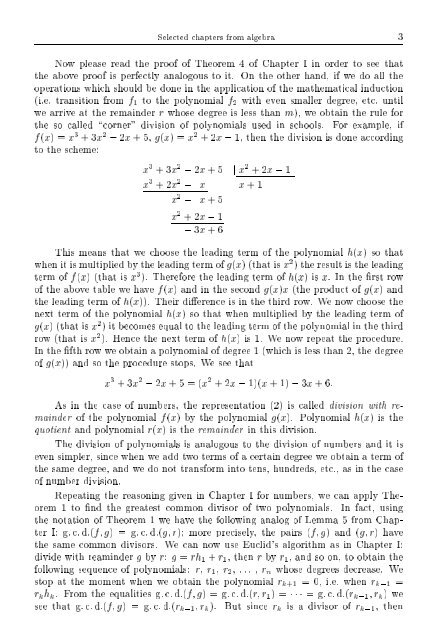SELECTED CHAPTERS FROM ALGEBRA I. R. Shafarevich Preface
SELECTED CHAPTERS FROM ALGEBRA I. R. Shafarevich Preface
SELECTED CHAPTERS FROM ALGEBRA I. R. Shafarevich Preface
You also want an ePaper? Increase the reach of your titles
YUMPU automatically turns print PDFs into web optimized ePapers that Google loves.
Selected chapters from algebra 3Now please read the proof of Theorem 4 of Chapter I in order to see thatthe above proof is perfectly analogous to it. On the other hand, if we doalltheoperations which should be done in the application of the mathematical induction(i.e. transition from f 1 to the polynomial f 2 with even smaller degree, etc. untilwe arrive at the remainder r whose degree is less than m), we obtain the rule forthe so called \corner" division of polynomials used in schools. For example, iff(x) =x 3 +3x 2 ; 2x +5,g(x) =x 2 +2x ; 1, then the division is done accordingto the scheme:x 3 +3x 2 ; 2x +5 j x 2 +2x ; 1x 3 +2x 2 ; x x +1x 2 ; x +5x 2 +2x ; 1; 3x +6This means that we choose the leading term of the polynomial h(x) so thatwhen it is multiplied by the leading term of g(x) (that is x 2 ) the result is the leadingterm of f(x) (that is x 3 ). Therefore the leading term of h(x) isx. In the rst rowof the above table we have f(x) and in the second g(x)x (the product of g(x) andthe leading term of h(x)). Their dierence is in the third row. We nowchoose thenext term of the polynomial h(x) so that when multiplied by the leading term ofg(x) (that is x 2 ) it becomes equal to the leading term of the polynomial in the thirdrow (that is x 2 ). Hence the next term of h(x) is1.We now repeat the procedure.In the fth row we obtain a polynomial of degree 1 (which is less than 2, the degreeof g(x)) and so the procedure stops. We see thatx 3 +3x 2 ; 2x +5=(x 2 +2x ; 1)(x +1); 3x +6:As in the case of numbers, the representation (2) is called division with remainderof the polynomial f(x) by the polynomial g(x). Polynomial h(x) is thequotient and polynomial r(x) istheremainder in this division.The division of polynomials is analogous to the division of numbers and it iseven simpler, since when we add two terms of a certain degree we obtain a term ofthe same degree, and we do not transform into tens, hundreds, etc., as in the caseof number division.Repeating the reasoning given in Chapter I for numbers, we canapply Theorem1 to nd the greatest common divisor of two polynomials. In fact, usingthe notation of Theorem 1 we have the following analog of Lemma 5 from ChapterI: g: c: d:(f g) = g: c: d:(g r) more precisely, the pairs (f g) and (g r) havethe same common divisors. We can now use Euclid's algorithm as in Chapter I:divide with reaminder g by r: g = rh 1 + r 1 , then r by r 1 , and so on, to obtain thefollowing sequence of polynomials: r, r 1 , r 2 , ... , r n whose degrees decrease. Westop at the moment when we obtain the polynomial r k+1 = 0, i.e. when r k;1 =r k h k . From the equalities g: c: d:(f g) =g: c: d:(rr 1 )= =g: c: d:(r k;1 r k )wesee that g: c: d:(f g) = g: c: d:(r k;1 r k ). But since r k is a divisor of r k;1 , then
















